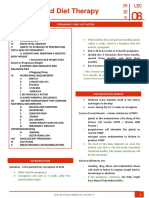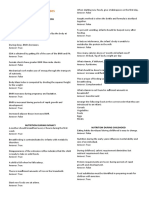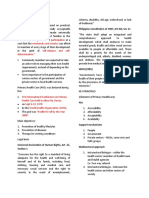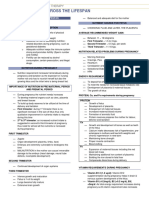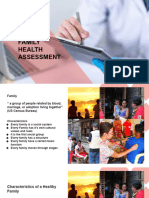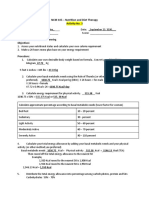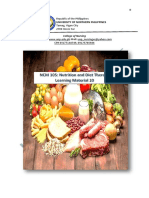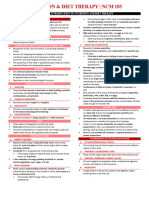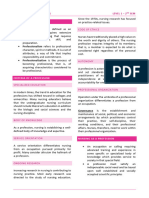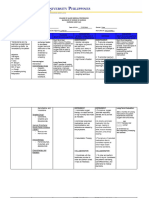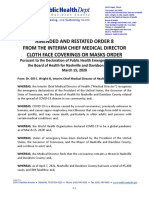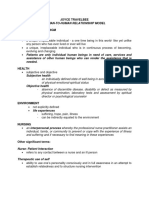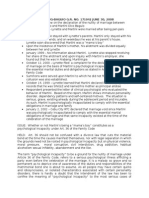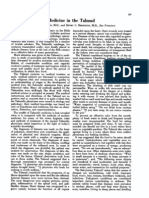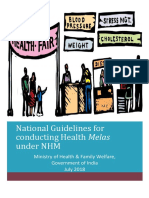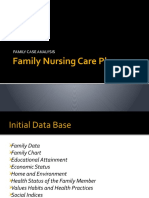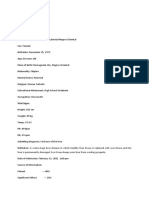0 ratings0% found this document useful (0 votes)
133 viewsNutrition and Diet Therapy Finals
Nutrition and Diet Therapy Finals
Uploaded by
grazelantonette.calubThis document discusses nutrition therapy and diet therapy in a hospital setting. It covers:
1) The role of nutrition therapy in treating conditions like diabetes and using medical nutrition therapy to aid recovery.
2) The responsibilities of nursing staff in monitoring patients' diets and educating patients.
3) Standard hospital diets including clear liquid, full liquid, soft diets and test diets/meals used to evaluate fat absorption.
4) The purposes of modified diets in illness and factors considered in planning modified diets for patients.
Copyright:
© All Rights Reserved
Available Formats
Download as PDF, TXT or read online from Scribd
Nutrition and Diet Therapy Finals
Nutrition and Diet Therapy Finals
Uploaded by
grazelantonette.calub0 ratings0% found this document useful (0 votes)
133 views8 pagesThis document discusses nutrition therapy and diet therapy in a hospital setting. It covers:
1) The role of nutrition therapy in treating conditions like diabetes and using medical nutrition therapy to aid recovery.
2) The responsibilities of nursing staff in monitoring patients' diets and educating patients.
3) Standard hospital diets including clear liquid, full liquid, soft diets and test diets/meals used to evaluate fat absorption.
4) The purposes of modified diets in illness and factors considered in planning modified diets for patients.
Original Title
NUTRITION-AND-DIET-THERAPY-FINALS
Copyright
© © All Rights Reserved
Available Formats
PDF, TXT or read online from Scribd
Share this document
Did you find this document useful?
Is this content inappropriate?
This document discusses nutrition therapy and diet therapy in a hospital setting. It covers:
1) The role of nutrition therapy in treating conditions like diabetes and using medical nutrition therapy to aid recovery.
2) The responsibilities of nursing staff in monitoring patients' diets and educating patients.
3) Standard hospital diets including clear liquid, full liquid, soft diets and test diets/meals used to evaluate fat absorption.
4) The purposes of modified diets in illness and factors considered in planning modified diets for patients.
Copyright:
© All Rights Reserved
Available Formats
Download as PDF, TXT or read online from Scribd
Download as pdf or txt
0 ratings0% found this document useful (0 votes)
133 views8 pagesNutrition and Diet Therapy Finals
Nutrition and Diet Therapy Finals
Uploaded by
grazelantonette.calubThis document discusses nutrition therapy and diet therapy in a hospital setting. It covers:
1) The role of nutrition therapy in treating conditions like diabetes and using medical nutrition therapy to aid recovery.
2) The responsibilities of nursing staff in monitoring patients' diets and educating patients.
3) Standard hospital diets including clear liquid, full liquid, soft diets and test diets/meals used to evaluate fat absorption.
4) The purposes of modified diets in illness and factors considered in planning modified diets for patients.
Copyright:
© All Rights Reserved
Available Formats
Download as PDF, TXT or read online from Scribd
Download as pdf or txt
You are on page 1of 8
NUTRITION AND DIET THERAPY
• Nutrition Therapy – treatment based on o Feeling deprived and punishes (pt.
nutrition. become more self-centered, irritable, or
o Checking person’s nutrition status and even angry)
giving right food or nutrients to treat RESPONSIBILITIES OF THE NURSING DEPARTMENT
conditions such as those cause by • Channel/bridge:
diabetes, heart disease, and cancer. o Nurse immediately forwards the diet
• Medical nutrition therapy – nutrition therapy prescription to the diet department
may help patients recover more quickly and • N.A. – monitoring
spend less time in the hospital. THE ROLE OF NURSES IN NUTRITIONAL CARE
OBJECTIVES OF NUTRITIONAL CARE IN DISEASE • Observing, listening, and reporting – 3 important
• Supply optimum nutrition functions
• Heal tissue, cure disease o Observing – checking you patient’s
• Support recovery from the disease condition
• Improve the function of the involved tissue or o Listening – understanding your patient
organ system o Reporting – acting on the information
• Reduce work of the affected organ to promote gathered
healing o Informal teaching – health education
FACTORS IN PLANNING MODIFIED DIET DIET THERAPY
• Disease state, its nature, duration, intensity • Appropriate diet is essential in the total care plan
• Food form or nutrient modification required by developed for every patient
the disease • Aims:
• Patient’s individual food tolerances and food o Maintain normal nutrition
habits o Correct nutritional deficiency
• Nutritional adequacy of modified diet o Change body weight
• Patient’s physical ability and home situation. o Adjusts the body’s ability to use one or
ILLNESS AND NUTRITION more nutrients
• Illness has many effects on body’s ability to use o Permits maximum rest to the body or an
nutrients based upon specific requirement organ
o Lack of appetite, vomiting, and pain –
prevent intake of sufficient amount of
food STANDARD HOSPITAL DIETS: LIQUID DIETS
o Fever – increase the rate of metabolism
o Metabolic disease (diabetes) – nutrients CLEAR LIQUID DIET
are not fully utilized • Allowance pf tea, coffee, or coffee substitute,
ILLNESS AND FOOD ACCEPTANCE and fat-free broth
• Comfort vs treatment of the patient • Ginger ale, fruit juices, gelatin, fruit ices, and
• Distress the patient rather provide immediate water gruels can also be given
comfort • Small amounts of fluid are offered every hour or
• Nurse plays an essential role of this gap two
• An illness may reduce a person’s interest in food • Used 24-48 hours ff. acute vomiting, diarrhea, or
o Gastric distention surgery
o Inactivity and intake of several drugs • Purpose: relieve thirst and maintain water
o Different food pattern and missing the balance
family FULL LIQUID DIET
o Worries of mounting bills • Liquids and foods that liquefy at body
o Changes in flavor, texture, etc temperature
• For acute infection, fever of short duration, and o Desserts: pies w/ tender crust, cakes, and
pt. to ill to chew puddings
• Progressive from clear fluid ff surgery
• Tx to GI upset STANDARD HOSPITAL DIET: TEST MEAL
• Offered in six feedings or more (gradual giving)
o Commonly followed full-liquid diet TEST MEALS
regimens • Fecal Fat Determination Test
▪ Breakfast o Measures fat globules in the stool to
• Vegetable juice detect fat absorption as in cases of cystic
• One bowl gelatin fibrosis
• One glass pulp-less fruit o Changes in stool consistency and odor
juice can indicate that your body isn’t
• One cup coffee or tea absorbing as much fat as it should
• Water • Purposes of fecal fat testing
• Supplement with honey o Fecal fat testing may be performed if
▪ Lunch your doctor suspected that your digestive
• Glass pulp-less fruit juice system isn’t functioning correctly. In a
normal person, the absorption of fat is
• Vegetable juice
based on variety of factors:
• One bowl gelatin
▪ Bile production in the gallbladder
• Broth
or liver, if your gallbladder was
• Cream soup
removed
• Beverage
▪ Production of digestive enzymes
• Water
in the pancreases
• Ice cream ▪ Normal functioning of the
▪ Supper intestines
• Glass pulp-less fruit juice o If any of these organs are not working
• Vegetable juice properly, your body might not be able to
• One bowl gelatin absorb as much fat as you need to
• Broth remain healthy and nourished.
• Coffee/tea Decreased absorption of fats can be a
• Supplement with sign of many different illness, including:
honey/nectar ▪ Celiac disease – this digestive
disorder damages the intestinal
STANDARD HOSPITAL DIET: SOFT DIETS lining. It’s caused by an
intolerance to gluten
SOFT DIETS ▪ Crohn’s disease – this
• Differs from the normal diet in terms of having: autoimmune inflammatory bowl
reduced fiber content, soft consistency, and disease affects the entire
bland flavor. digestive tract
• Used immediately after full liquid diet ▪ Cystic fibrosis – the genetic
• Modified from normal diet in the ff ways: disease results in thick mucus
o Meat and poultry are minced and secretions in the lungs and
ground. Tender fish w/o digestive tract
o Vegetables, diced, or chopped are ▪ Pancreatitis – this condition is an
cooked (may be cooked a little longer to inflammation of the pancreases.
make sure it’s soft) ▪ Cancer – tumors in the pancreas
o Soft raw fruits or biliary ducts can affect your
o Soft roll, breads, biscuits body’s absorption of fat.
OTHER TEST MEALS o Age of family members
• Meat-free test o Storage and preparation facilities
o Used to determine GIT bleeding. A 3-day o Cooking skills
diet excludes ingestion of meat, poultry, Dietary standard → Recommended Dietary Allowance →
and fish. recommended Energy and Nutrient Intakes
• Calcium test • Giving emphasize that standards should be in
o Used to determine urinary calcium nutrients and not on food or diets.
excretion to diagnose hypercalciuria. The • Recommended Energy and Nutrient Intakes – are
diet required 1000 mg calcium intake. levels of intake and nutrients which, on the basis
400 mg from food source and 600 mg of current scientific knowledge are considered
oral supplements. adequate for the maintenance of health and well-
• Serotonin Test being of nearly persons of the population.
o Used to detect carcinoid tumors of the • Essentials of an Adequate Diet
intestinal tract. Food rice in serotonin is o proteins, carbohydrates, fats, vitamins,
excluded in the diet. minerals, cellulose, and water should be
NORMAL DIET MODIFICATION provided in sufficient quantity through
• Modification is needed in a therapeutic sense the daily meals to meet the needs of the
• Normal diet may be modified for body
o Consistency and texture o Meat group
o Flavor ▪ Provide generous amount of
o Energy value high-quality protein
o Nutrient level ▪ Iron, thiamine, riboflavin, niacin,
o Food categories phosphorus, and zinc are
• AIM: keep as many characteristics of the normal supplied
diet as possible ▪ Liver, kidney, saltwater fish
GOOD TRAY SERVICE should be included in the animal
• Sufficient size tray, uncrowded arrangements of protein allowance
dishes ▪ Plant-source/nonmeat
• Clean, unwrinkled tray cover and napkin of linen alternatives can also be provided.
or good quality paper o Bread and cereal group
• Attractive pattern of spotless chinaware w/o ▪ Furnished thiamine, protein, iron,
chips or cracks, clean glassware and shining niacin, carbohydrate, and
silverware cellulose at a relatively low cost.
• Orderly arrangement of all items o Vegetable-fruit group
• Portions of food suitable for pt’s appetite ▪ Important supplier of fiber,
• Food attractively arranged minerals, and vitamins
particularly vitamin A and C
• Meals served on time
• Assessment of nutritional status
• Hot food served and kept warm, cold foods
o Nutritional assessment (nutriture)
served on chilled dishes
▪ Degree to which the individual’s
• Trays promptly served to the patient
physiological need for nutrients
is being me by the food the
person eats.
RECOMMENDED DIETARY ALLOWANCES AND
▪ It is the state of balance in the
ADEQUATE DIET
individual between the nutrient
• Factors to considered in planning nutritious
intake and the nutrient
meals
expenditure or needed.
o Regional availability of foods
o Evaluation of the Nutritional Status
o Socio-economic conditions
involves
o Taste preferences
o Food habits
▪ Examination of the individual’s • Home life and meal
physical condition patterns
▪ Growth and development • Appetite
▪ Behavior • Allergies, intolerances,
▪ Blood and tissue levels of and food avoidance
nutrients • Dental and oral health
▪ Quality and quantity of nutrient • Gastrointestinal concerns
intake • Chronic diseases
o In a thorough nutritional status • Medication
assessment, all of the following aspects o Food diary or Record
are considered: ▪ This method involves time,
▪ Dietary history and intake understanding, and motivation
▪ Biochemical date on the part of the patient or
▪ Clinical examination client. The subject is asked to
▪ Anthropometric data write down everything he/she
▪ Psychosocial data eats drinks for a certain time.
• Methods of Assessing Dietary Intake Three days, particularly two
o 24-hour recall weekdays and one weekend day,
▪ The individual completes a have been found to be a
questionnaire or is interviewed representative time period of
by a dietitian/nutritionist, or a most people.
nurse experienced in dietary o Observation of food intake
interviewing and is asked to ▪ The most accurate method of
recall everything that he/she ate dietary intake assessment but
within the last 24 hours or also the most time-consuming,
previous day expensive, and difficult. It
▪ “In order to get a more complete requires knowing the amount
picture of your family’s health, I and kind of food presented to
need to know more about you the person and the record of the
eating habits. Would you please amount actually taken.
tell me everything you ate or • Evaluation of the Food Intake Data
drank all day yesterday? Let’s o Evaluation by food group method
begin with:” ▪ The simplest and fastest, yet
o Food frequency questionnaire crudest way to evaluate food
▪ Questions, should be modified intake data is to determine how
based on the information from many servings from each of the
the 24-hour recall four group were consumed
o Diet history during the recorded day. The
▪ More complete than either the number of servings is suggested
24-hour recall or food frequency in the basic four or seven food
questionnaire, though it usually plans.
includes both of these sources. o General rules of meal planning
The dietary history contains ▪ Use the whole day as unit rather
additional information about the than the individual meal. Make
following breakfast relatively simple and
• Economic standardized, the plan dinner.
• Physical activity Lastly plan lunch and snacks to
• Ethnic and cultural supplement the other two meals
background
▪ Use some food from each of the methods together with an evaluation of the
food groups daily (regulating, ecological factors of the community
energy-giving, bodybuilding) SIGNIFICANCE OF NUTRITIONAL ASSESSMENT
▪ Use some raw fruits or • It is the first essential in nutritional planning
vegetables at least once daily. • It provides data and information for planning and
▪ Plan to have for each meal at evaluation
least one food with staying • It helps define priorities and responsibilities of
power or high in satiety value, public health system at the national, regional,
one which contains roughage provincial, city, municipal, and barangay levels.
(fibrous), and generally some hot METHODS OF NUTRITIONAL ASSESSMENT
food or drink. • Method that provides direct information
▪ Combine or alternate foods of o clinical examination
bland form with those of a more o biochemical examination
pronounced flavor o anthropometric measurement
▪ Combine and alternate foods soft o biophysical technique
and crisp foods • method that provides indirect information
▪ Have a variety of color, food, and o studies on food consumption
food arrangement o studies on health conditions and vital
▪ When more foods are served at statistics
one meal, decrease the size of o studies on socio-economic conditions
portions, and used fewer rich o studies on cultural and anthropological
foods. influences
• According to one • Factors considered in the selection of nutrition
dictionary, rich as applied survey method
to food means fatty, oily, o Unit to be surveyed
or sweet, or highly o Types of information required
seasoned. o Degree of reliability and accuracy
o Some don’ts for Menu Planning acquired
▪ Avoid using the kind of food o Human resources
twice a day w/o varying the form o Time reference
in which it is served except o Funding or financial support
staples like rice, bread, and milk. • Features of methods and reference standards
▪ Do not use the same food twice used
the same meal even in different o Clinical assessment – deals with the
forms. examination of changes that can be seen
▪ Do not use the same food too or felt in superficial tissues such as skin,
often from day to day hair, eyes
o Other considerations: ▪ Advantages
▪ Meal patterns. Meal or menu • More coverage in a short
patterns are helpful in planning, time
but they must consider the • Inexpensive; no need for
family’s habit and needs. sophisticated equipment
▪ Planning for the week. Best to ▪ Disadvantages
have weekly menu plan. In • Non-specificity of signs
hospitals, the practice of
• Overlapping of deficiency
dietitians is to prepare a so-called
state
“cycle menu”
• Bias of the observer
NUTRITIONAL SURVEY
▪ Clinical signs – known to be value
• Is a epidemiological investigation of the
in nutrition surveys and their
nutritional status of the population by various
interpretations
o Biochemical assessment – estimation of
time desaturation, enzymes activity, or
blood composition
▪ Test are confined to two fairly
easily obtained fluids: blood,
urine
▪ Results are generally compared
to standards – normal levels for
age and sex
▪ Advantages
• Objectivity, independent
of the emotional and
subjective factors that
usually affect the
investigators
• Can detect early
subclinical states of
nutritional deficiency
▪ Disadvantages
• Costly, usually requiring
expensive equipment
• Time-consuming
▪ Factors affecting accuracy of
results
• Standards of collection
• Methods of transport
and storage of samples
• Techniques employed
▪ Common biochemical
parameters/tests
• Anthropometric Measurements – the
measurement of variations of the physical
dimensions and gross composition of the human
body at different age levels and degrees of
nutrition
o Common anthropometric measurements
• Clinical assessment
o Protein-energy malnutrition
▪ Mild to moderate
▪ Severe
• Marasmus (fry form)
• Kwashiorkor (edematous
form)
• Marasmic kwashiorkor
o Xeropthalmia – affects the eyes,
gradually beginning with an impairment
of night vision. Initial stages may be
treated by the supplementation of the
daily diet with vitamin A. Severe cases
need large supplements and
simultaneous treatment of the eye
problem with antibiotics
▪ Impaired night vision
▪ Smokey conjunctive
▪ Dry eyes
▪ Cornea softening and ulcers
o Prevalence criteria for determining the
public health significance of
exophthalmia and vitamin A deficiency in
children aged 6 months to 6 years
o Anemia – sole reliance on breast milk for
children beyond 6 mos. Leads to anemia.
Since blood cells require both protein
and iron for their formation, treatment
should concentrate on supplementing
their nutrients in the diet
▪ Tiredness
▪ Paleness under the eyelid
▪ Breathlessness
▪ Heart palpitation
▪ Paleness under the nails
▪ Edema
o Goiter – enlargement of the thyroid
glands is due to its need for iodine.
Common in female
▪ Swelling of the neck
▪ Difficulty in breathing
▪ Difficult in swallowing
▪ Tight feeling in throat
o Vitamin B2 or Riboflavin Deficiency
▪ Magenta red tongue
▪ Sores at the angle of the mouth
and folds of the nose
▪ Itching and scaling of skin around
nose, mouth, scrotum, forehead,
ears, scalp
• Biochemical assessment deficiency probably up to 1 year
o Protein in adults and up to 4 months in
▪ Amino acid imbalanced test young children.
• Ratio of four dispensable ▪ Serum carotene level in not
amino acids and four indicative ingestion of carotene-
indispensable amino containing foods.
acids in serum by paper ▪
chromatography
• High (5-10) in
kwashiorkor and low
(less than2) in well-fed
children
▪ Hydroxyproline excretion in
random urine
• Low (0.5-1.5) in clinically
malnourished children;
normal 2.0 to 5.0
▪ Serum albumin
• Lowered in severe
protein depletion
• Guide in interpretation
(g/100ml)
o High – 4.25
o Acceptable –
3.52 – 4.24
o Low – 2.80 – 3.51
o Deficient – less
than 2.80
o Iron
▪ Hemoglobin determination
• Cyanmethemoglobin
method by
spectrophotometry
▪ Hematocrit
• Obtained from a finger
prick
• Values below which
anemia is said to exist
o Vitamin A
▪ Serum vitamin A and serum
carotene level by
spectrophotometry using micro
and macro methods
▪ Low serum vitamin A reflects
prolonged sever, dietary
You might also like
- He Principles Theories in Teaching Learning NOTESDocument5 pagesHe Principles Theories in Teaching Learning NOTESAriane NobleNo ratings yet
- Lecture - Nutrition and Diet TherapyDocument9 pagesLecture - Nutrition and Diet TherapyLalaine Marie BianzonNo ratings yet
- Ncma215 FinalDocument21 pagesNcma215 FinalMakspeyn del Valle - Moon100% (1)
- Therapeutic Diet Group 7Document64 pagesTherapeutic Diet Group 7renz bartolomeNo ratings yet
- Module 2 (Midterm) Primary Health Care (PHC)Document17 pagesModule 2 (Midterm) Primary Health Care (PHC)DianneNo ratings yet
- NDT Lec Midterm ReviewerDocument50 pagesNDT Lec Midterm ReviewerG05. Del Castillo, Angela Marie D.No ratings yet
- M1 NutritionAndDietTherapy-TRANSESDocument5 pagesM1 NutritionAndDietTherapy-TRANSESrishellemaepilonesNo ratings yet
- NCM 105 Quizzes: Dietary ComputationsDocument2 pagesNCM 105 Quizzes: Dietary ComputationsMarielle ChuaNo ratings yet
- Nutrition Intervention in Infancy Group 4Document56 pagesNutrition Intervention in Infancy Group 4Cristelle Joy RebocaNo ratings yet
- Self Learning Module For Unit 1 Skill For DemonstrationDocument35 pagesSelf Learning Module For Unit 1 Skill For DemonstrationMarlon Glorioso IINo ratings yet
- NCM 105 - Nutrition and Diet Therapy Activity No: 2: 44kg (1.55) 44kg 2.4025 96.8 LBS× 705 (61.02) 68244 3723.88Document3 pagesNCM 105 - Nutrition and Diet Therapy Activity No: 2: 44kg (1.55) 44kg 2.4025 96.8 LBS× 705 (61.02) 68244 3723.88Mary Charlotte PableoNo ratings yet
- 1.Chn Introduction and FamilyDocument7 pages1.Chn Introduction and FamilyLuzie Mae SuanNo ratings yet
- Primary Health CareDocument14 pagesPrimary Health CarelanNo ratings yet
- NCM 105 Prelim Notes Nutrition and Diet TherapyDocument21 pagesNCM 105 Prelim Notes Nutrition and Diet Therapys.labita.sherynejoelNo ratings yet
- NCM 105 - NDDocument2 pagesNCM 105 - NDYsabelle Gutierrez100% (1)
- Nutrition and Diet TherapyDocument11 pagesNutrition and Diet TherapyKathleen Martinez100% (2)
- 215 TransesDocument8 pages215 Transeskim jenNo ratings yet
- "NCM 105 Laboratory" "Assignment #1 "Document7 pages"NCM 105 Laboratory" "Assignment #1 "Joan BabieraNo ratings yet
- 05 - LEC Introduction To Therapeutic Nutrition and Food Borne IllnessDocument16 pages05 - LEC Introduction To Therapeutic Nutrition and Food Borne IllnessJAN CAMILLE LENONNo ratings yet
- NutLab1 Physiologic Value of Food Activity FDocument2 pagesNutLab1 Physiologic Value of Food Activity Frichelleambrocio054No ratings yet
- (NCM 105) Nutrition Across The LifespanDocument4 pages(NCM 105) Nutrition Across The Lifespanberanabigail0No ratings yet
- Chapter 1 NCM 104Document3 pagesChapter 1 NCM 104reajohn591No ratings yet
- NUTRI LAB P1 ExamDocument7 pagesNUTRI LAB P1 ExamAllyza Jane SartigaNo ratings yet
- CHN Midterm Exam CoverageDocument6 pagesCHN Midterm Exam CoverageRoshin Tejero100% (1)
- Community Health Nursing - Family AssessmentDocument57 pagesCommunity Health Nursing - Family AssessmentRhizel Marie Cauilan FariñasNo ratings yet
- IMCI (Integrated Management of Childhood Illness)Document4 pagesIMCI (Integrated Management of Childhood Illness)Jane BautistaNo ratings yet
- Fundamentals of Nursing 11 NutritionDocument23 pagesFundamentals of Nursing 11 NutritionAnnie Rose Dorothy MamingNo ratings yet
- Midterm NutriDocument66 pagesMidterm NutriMaye ArugayNo ratings yet
- RLE Bag TechniqueDocument22 pagesRLE Bag TechniqueJa Flores100% (1)
- NCM 105 - Nutrition and Diet Therapy Activity No. 3Document4 pagesNCM 105 - Nutrition and Diet Therapy Activity No. 3Mary Charlotte PableoNo ratings yet
- NutLab 5 Calculating Diets and Meal PlanningDocument11 pagesNutLab 5 Calculating Diets and Meal PlanningJamie AmortizadoNo ratings yet
- Week 7. 2 CHN-FNCPDocument51 pagesWeek 7. 2 CHN-FNCPPatrick Jumao-asNo ratings yet
- Funda Lec ReviewerDocument16 pagesFunda Lec ReviewerTricia Maxine DomingoNo ratings yet
- NCM 107a Care of The Pregnant WomanDocument43 pagesNCM 107a Care of The Pregnant WomanMelchizedek Tagarino Torio100% (1)
- Republic of The Philippines Tamag, Vigan City 2700 Ilocos SurDocument16 pagesRepublic of The Philippines Tamag, Vigan City 2700 Ilocos SurJewel Ramos GalinatoNo ratings yet
- Nutrition and Diet TherapyDocument24 pagesNutrition and Diet TherapyKimberly Marie BayangNo ratings yet
- Family Health Care Process-ChniiDocument14 pagesFamily Health Care Process-ChniirodcyruskentNo ratings yet
- Activity # 5 - Santos, Aira Kristelle MDocument7 pagesActivity # 5 - Santos, Aira Kristelle MAi MendozaNo ratings yet
- Perdido - Activity 1 Feeding Pregnant and Lactating WomenDocument4 pagesPerdido - Activity 1 Feeding Pregnant and Lactating WomenKariza Perdido100% (1)
- Prelim Care of Mother Child Adolescent Lec TransesDocument9 pagesPrelim Care of Mother Child Adolescent Lec TransesJay Estrella50% (2)
- Learning Objectives: Facilities:: NCM 102 Final Term Part I VideoDocument53 pagesLearning Objectives: Facilities:: NCM 102 Final Term Part I VideoAmber De la CernaNo ratings yet
- 11 Nutrition Across The Lifespan - InfancyDocument39 pages11 Nutrition Across The Lifespan - InfancyKathleen Ang100% (1)
- Module 1 Basics of Nutri-Diet Therapy Week 1Document34 pagesModule 1 Basics of Nutri-Diet Therapy Week 1ShenaNo ratings yet
- Nutri & Diet MidtermDocument4 pagesNutri & Diet MidtermronronNo ratings yet
- WEEK 1 CU1 History of Health EducationDocument5 pagesWEEK 1 CU1 History of Health EducationDaichi100% (1)
- Department of Health: "Quality Is Above Quantity" - Philosophy of DOHDocument2 pagesDepartment of Health: "Quality Is Above Quantity" - Philosophy of DOHPatricia RamosNo ratings yet
- Healthy Living Made EasyDocument2 pagesHealthy Living Made EasyHealthy LifestyleNo ratings yet
- Nutrition and Diet Therapy BSN 2Document9 pagesNutrition and Diet Therapy BSN 2Frannie Alyssa MataNo ratings yet
- WS7 Nutritional AssessmentDocument10 pagesWS7 Nutritional Assessmentivy annNo ratings yet
- Chapter 1 Introduction To Nutrition and Diet TherapyDocument2 pagesChapter 1 Introduction To Nutrition and Diet Therapyreajohn591No ratings yet
- Nutrition and Diet Therapy - LEC (5,6,7)Document9 pagesNutrition and Diet Therapy - LEC (5,6,7)Anntwilight MontesNo ratings yet
- BY Nelson Munthali Dip/RNDocument56 pagesBY Nelson Munthali Dip/RNArmySapphireNo ratings yet
- Student Copy Conti - Intrapartal Week8Document25 pagesStudent Copy Conti - Intrapartal Week8Toyour EternityNo ratings yet
- 6322b0cc8d37d Notes in NCM 103 Fundamentals of NursingDocument18 pages6322b0cc8d37d Notes in NCM 103 Fundamentals of NursingMJ ArazasNo ratings yet
- Nutri Nclex QuestionsDocument2 pagesNutri Nclex QuestionsSaidinaNo ratings yet
- NCM 112 - Sexually Transmitted Disease (STD)Document4 pagesNCM 112 - Sexually Transmitted Disease (STD)Cailah Sofia SelausoNo ratings yet
- LIFE CYCLE NUTRITION - Pregnancy and Lactation 2Document63 pagesLIFE CYCLE NUTRITION - Pregnancy and Lactation 2Ruby Ann David-DancelNo ratings yet
- Group 4 Report in NutritionDocument48 pagesGroup 4 Report in Nutritionfe espinosaNo ratings yet
- Theories Related To Health PromotionDocument12 pagesTheories Related To Health PromotionJamie Rose FontanillaNo ratings yet
- Perioperative NursingDocument36 pagesPerioperative Nursinggrazelantonette.calubNo ratings yet
- Multiple Sclerosis 1.1. Definition: Immunologic DisorderDocument21 pagesMultiple Sclerosis 1.1. Definition: Immunologic Disordergrazelantonette.calubNo ratings yet
- Skin Integrity and Wound CareDocument28 pagesSkin Integrity and Wound Caregrazelantonette.calubNo ratings yet
- Acute Coronary Syndrome Acs 2Document6 pagesAcute Coronary Syndrome Acs 2grazelantonette.calubNo ratings yet
- Fluids and Electrolytes AbnormalDocument25 pagesFluids and Electrolytes Abnormalgrazelantonette.calubNo ratings yet
- NCP GeriaDocument6 pagesNCP Geriagrazelantonette.calubNo ratings yet
- Fish or Shrimp Grow Out Operation CG 1Document8 pagesFish or Shrimp Grow Out Operation CG 1Eugene SaldivarNo ratings yet
- Mosaraf Hossain Tata FileDocument7 pagesMosaraf Hossain Tata FileCHIRANJIT.SIBANINo ratings yet
- Amended and Restated Order 8Document6 pagesAmended and Restated Order 8Anonymous GF8PPILW5No ratings yet
- 11 - Joyce TravelbeeDocument2 pages11 - Joyce TravelbeeRonnie De Vera UnoNo ratings yet
- AGING IN THE 21st CENTURY A SOCIOLOGICAL ANALYSIS OF SENIOR CITIZENS SPECIAL REFERENCE TO PAKALVEEDU IN THRISSUR DISTRICTDocument32 pagesAGING IN THE 21st CENTURY A SOCIOLOGICAL ANALYSIS OF SENIOR CITIZENS SPECIAL REFERENCE TO PAKALVEEDU IN THRISSUR DISTRICTClassic PrintersNo ratings yet
- Project ProposalDocument3 pagesProject ProposalJackie KendiNo ratings yet
- Mental Health Self Care Presentation HOMEROOM 2Document47 pagesMental Health Self Care Presentation HOMEROOM 2Anelyn Carcillar100% (2)
- 301 Chapter 2 HazardDocument19 pages301 Chapter 2 Hazardnini jasniNo ratings yet
- Thesis For RoutingDocument75 pagesThesis For RoutingErnesto Soriano BasingaNo ratings yet
- Healthsystem IndiaDocument151 pagesHealthsystem IndiasanjnuNo ratings yet
- Republic V CabantugDocument2 pagesRepublic V Cabantugmelaniem_10% (1)
- Medicine in The TalmudDocument2 pagesMedicine in The TalmudMichaelNo ratings yet
- ESISDocument70 pagesESISritikaritikaNo ratings yet
- Grammar 10th EFL 2024 25Document52 pagesGrammar 10th EFL 2024 25abdulrihan8905No ratings yet
- FNCP CHNDocument3 pagesFNCP CHNMARY EDELLA ACOBNo ratings yet
- Book of Abstracts Sra E2017Document177 pagesBook of Abstracts Sra E2017Luiz Augusto CostaNo ratings yet
- Bookshelf NBK83689Document235 pagesBookshelf NBK83689Koordinator PraklinNo ratings yet
- Karauli Dham IntroductionDocument48 pagesKarauli Dham IntroductionYajush RaoNo ratings yet
- Final Health Mela Guidelines - 1Document19 pagesFinal Health Mela Guidelines - 1Rohit VermaNo ratings yet
- Of THR: TNCRDocument12 pagesOf THR: TNCRKram Anonuevo YatigalNo ratings yet
- A Randomized Controlled Trial of Smoking Cessation Methods in Patients Newly-Diagnosed With Pulmonary TuberculosisDocument9 pagesA Randomized Controlled Trial of Smoking Cessation Methods in Patients Newly-Diagnosed With Pulmonary TuberculosisAkhirul NuzulNo ratings yet
- SAF General Medicine 17-03-2020Document43 pagesSAF General Medicine 17-03-2020manoj yadavNo ratings yet
- Industrial Nurses Render First Aid and Treatment To Injured or Ill Employees at FactoriesDocument5 pagesIndustrial Nurses Render First Aid and Treatment To Injured or Ill Employees at FactoriesRiezel Guzmana AceroNo ratings yet
- Sample Test 1 - QuestionnaireDocument5 pagesSample Test 1 - QuestionnaireAira CatubayNo ratings yet
- Healthmedicinet I 2017 2Document598 pagesHealthmedicinet I 2017 2tuni santeNo ratings yet
- Family Nursing Care PlanDocument21 pagesFamily Nursing Care PlanCarol MalcoNo ratings yet
- Treatment of Personality DisorderDocument10 pagesTreatment of Personality DisorderEvasivo28No ratings yet
- Illness ExpressionsDocument5 pagesIllness ExpressionsMichelle Susunaga RomeroNo ratings yet
- Cabaluna, Krizzia Franz L. BSN 1A: Biographical DataDocument7 pagesCabaluna, Krizzia Franz L. BSN 1A: Biographical DataNeølie Abello LatúrnasNo ratings yet
- Delhi Jail Manual (1) - 5Document10 pagesDelhi Jail Manual (1) - 5JaJaNo ratings yet





